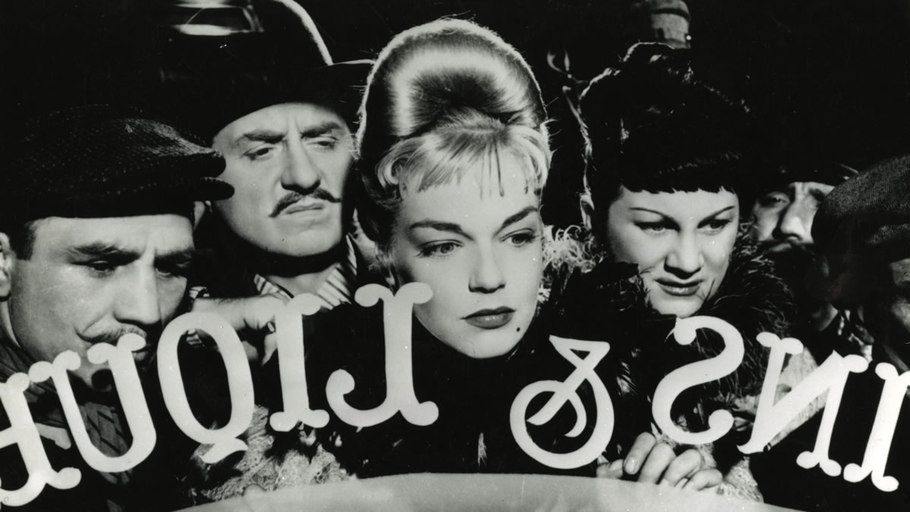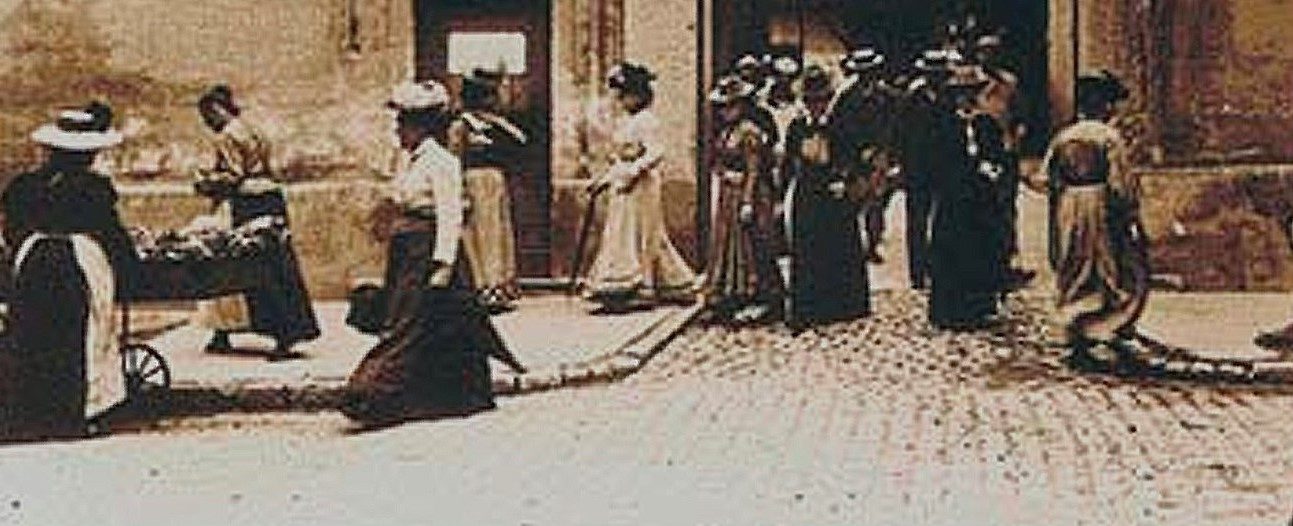France, 1952
Directed by Jacques Becker
With Simone Signoret (Marie), Serge Reggiani (Georges Manda), Claude Dauphin (Félix Leca), Raymond Bussières (Raymond), William Sabatier (Roland Dupuis)

The establishing shot on the quiet, sunny, scenic section of the Seine river where folks are gaily rowing and the following string of short, carefully choreographed and composed shots showing these folks frolicking and enjoying the day in an open air café complete with a dance floor, are immediately, effortlessly, pleasantly reminiscent of Impressionism’s paintings or Guy de Maupassant’s short stories. It is Belle Époque France at its most conspicuous and charming, the starting point of a possibly slight but alluring tale.
It turns out to be far darker and far intenser, and far more cinematic too. The screenplay is based on a “fait divers” – a crime story set to fill the rest of the columns of the daily newspapers after more serious issues got reported, usually barely noticeable but sometimes really catching the attention – that stunned the public in 1898, although key details have been altered. It relates the growing competition between two men, one a gang leader and the other a joiner with a troubled past, for the love of a prostitute.
It actually starts with the anger of a third character, petty thief Roland Dupuis, who resents how his official girlfriend, the bright young lady he views too easily as a private property, Marie, gets interested, in the open air café, in a thin, serious but nice-looking young fellow who came with his boss to fix the platform for the orchestra, Georges Manda, and who also happens to be an old pal of a sidekick of Roland Dupuis, one of the folks who where on the river and emerge now as a gang, Raymond. When the confident prostitute gets the reluctant joiner to dance with her, the sheer pleasure and amazing chemistry the couple experiences and conveys worsen the situation. It is a few days later, in a Paris street, when Marie pays a visit to Georges Manda’s workshop that things move into a far more dangerous but quite definitive and essential direction.
The clash between the former gangster and the arrogant one is inevitable and actually organized and watched by Roland Dupuis’s gang leader, a suave, sleek, and sleazy wine trader, Félix Leca. Roland Dupuis gets killed. That may get Georges Manda into trouble, though Félix Leca sees it it cannot, and obviously allow him to get Marie for himself. But it is not just she is disgusted by the violence: it turns out Félix Leca loves her too, and actually flirted in the past with her, and slowly the narrative becomes the clash between two lovers dreaming to stay together and free and a vicious and jealous guy reckoning how to get the bond broken, to get Marie back, and to get rid of Georges. Félix Leca would not refrain from sacrificing a partner as reliable as Raymond, helping the police to arrest him for the murder of Roland Dupuis, hoping that Georges would give up himself to spare his dear old friend. He is proved right, but a remark made by a police detective that failed to remain secret betrays him – and he would not escape Georges’s vengeance.
But however cleverly the events are told, with a deft sense for the revealing detail fascinating the audience and a lively, wonderful touch for capturing the behaviors, moods, and tics of various characters, even the most anecdotal one, the film remains a striking study in stares, transfixed and passionate looks a person gives or exchange. A splendid vehicle for the uncanny beauty and the cheeky allure of lead actress Simone Signoret, “Casque d’or” is built around the power of gaze and the charm of eyes. Through moving, intense close-ups, the film displays the mesmerizing and magnetic stares love can foster: it is such a gaze that signals the transformation, in the guinguette, at the beginning, of Marie from a buoyant, spirited, but constrained and typical prostitute into a truly ardent and diehard romantic character, with the possibility of tragedy already looming over her. Her gaze would keep haunting both Georges Manda and the audience.
It is one of these magical, moving gazes that brings the film to a turning point, which is also a bold editing cut. She has managed to draw Georges into a distant farm near the Seine, now determined, after the shock caused by the violence, to love him more than ever and to stay with him (her later, mischievous whim to step in a church while a wedding ceremony is in progress leaves little doubt about her real will). He has fallen asleep on the grassy bank: she lies next to him, tickles him with a straw to wake him up, the editing swiftly switching between her playful gestures and her amorous gaze, shot from where his head lies (a POV shot whose nature and impact becomes plain only at the end of the scene), till he does wake up. He cannot see anything else than her face, who gets blurred: the movie then cuts into a bedroom where both are sleeping, till he wakes up again and gets out of the bed, clearly in the buff. Love has been consummed, happiness found and claimed, a point of no return reached, and the audience left with an audacious ellipsis suggesting how overpowering and fiery lust has been – and could be.
The most poignant and even more radical observation of gazes comes with the dramatic ending, in two steps. The race for survival ofFélix Leca involves some of the most resolute, relentless, ruthless gazes of the film, from a Georges Manda mad with anger and determined to obtain justice his own, visceral way – the closeups are more than riveting, genuinely chilling, while giving the tranquil, gentle face of lead actor Serge Reggiani an intensity and impact harking back to the initial shots, when his burning eyes were then set on the unexpected beauty of Marie. And the second time belongs to her, as she has settled high in a tenant building to watch the execution of her lover for two homicides. Her transfixed gaze and intent face lower one after the other after the guillotine worked, a move downwards expressing the end of everything. What is left of her, visually, is ironically the stunning hairdo that was her trademark and gives the film its title, this carefully elaborate shock of blond hair, this great golden helmet: nodding to the ground, it acknowledges that love and life are no more. The feisty girl is now a symbol of tragedy, as a pleasant chronicle has morphed into a heartbreaking and profound story of fatum and grief.

